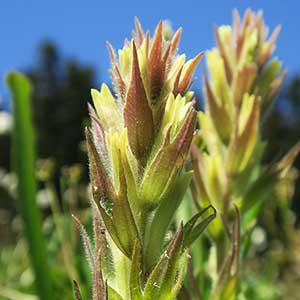Castilleja cryptantha
Castilleja fraterna
Mt. Rainier or obscure paintbrush, obscure Indian paintbrush, obscure paintbrush
fraternal Indian paintbrush, fraternal paintbrush
few to several, erect or ascending, unbranched, hairs spreading, long, soft, eglandular, mixed with short stipitate-glandular ones.
few to many, ± curved at base, ascending or erect distally, unbranched, hairs moderately dense, spreading, medium length and long, soft, mixed with shorter stipitate-glandular ones.
green, often with brown or purple veins, narrowly to broadly lanceolate, 1.5–4 cm, not fleshy, margins plane, ± involute, 0–3-lobed, apex acute to acuminate;
lobes spreading-ascending, narrowly lanceolate, apex acute to ± obtuse.
green, sometimes purple-tinged, lanceolate, broadly lanceolate, or narrowly ovate, 1–4.3 cm, not fleshy, margins plane, sometimes ± wavy, ± involute, 0–3-lobed, apex acute to acuminate;
lobes ascending, often narrowly oblanceolate, apex acute to acuminate.
(2.5–)3–6 × 1–2 cm; green to dull brown or dull reddish purple throughout, or proximally green to dull brown or dull reddish purple, distally yellow on apices, broadly lanceolate to ovate, (0–)3-lobed;
lobes ascending, narrowly lanceolate, long or short, arising near mid length, apex acute or acuminate.
3–8.5 × 1–4 cm;
bracts greenish or bright to sometimes dull red, sometimes scarlet, orange, or pale pink throughout, or proximally greenish, distally as above, ovate to elliptic, (0–)3-lobed;
lobes ascending, lanceolate to narrowly triangular, short, arising above mid length, apex acute to obtuse or acuminate.
straight, 14–16 mm;
tube 11–14 mm;
whole corolla included within calyx;
beak adaxially pale yellow, 1–2 mm;
abaxial lip deep green, slightly inflated, 4–5 mm, 67% as long as beak;
teeth ascending, pale, 1.5–2 mm.
straight or slightly curved, 20–40 mm;
tube 27 mm;
abaxial lip often visible in abaxial cleft, sometimes exserted, beak usually exserted from calyx;
beak adaxially green to yellow, 8–14 mm;
abaxial lip red, black, green, white, or green and white, ± prominent, slightly rounded, 1.5–5 mm, ca. 33% as long as beak;
teeth ascending, green, bright red, pink, white, or yellow, 0.5–3 mm.
proximally green or pale with green veins, lobes yellow, sometimes becoming deep red with age, 12–15 mm;
abaxial and adaxial clefts 3–7 mm, 25–50% of calyx length, deeper than laterals, lateral 1–3(–4) mm, 8–20% of calyx length;
lobes triangular, adaxial segments longer than abaxials, apex acute or obtuse.
brightly, conspicuously colored for at least distal 2/3, often throughout, providing much of inflorescence coloration, proximally pale whitish to pale pink, distally colored as in distal portion of bracts, sometimes colored throughout as in distal portion of bracts, 15–30 mm;
abaxial and adaxial clefts 7–14 mm, 33–50% of calyx length, deeper than laterals, lateral 1–5 mm, 5–15% of calyx length;
lobes narrowly to broadly triangular, apex rounded to acute.
= 24.
Castilleja cryptantha
Castilleja fraterna
Castilleja cryptantha is endemic to the vicinity of Mt. Rainier in the Cascade Range, with most populations found within Mt. Rainier National Park. Unlike most species of Castilleja, it is apparently self-pollinating (W. J. Duffield 1972); the small flowers are entirely enclosed within the yellowish calyces, which tend to grow deep reddish as they age. The purplish brown bracts are also unusual in the genus.
(Discussion copyrighted by Flora of North America; reprinted with permission.)
Castilleja fraterna is endemic to one ridge system in the Wallowa Mountains of northeastern Oregon. A parallel ridge system in the range has a second Wallowa Mountains endemic, C. rubida. Castilleja fraterna is colored similarly to C. miniata, but the petaloid teeth of the abaxial corolla lip are more like C. chrysantha. It is possible that C. fraterna was derived through hybridization, though its chromosome number is unknown. It resembles the newly described C. kerryana in Montana.
(Discussion copyrighted by Flora of North America; reprinted with permission.)


